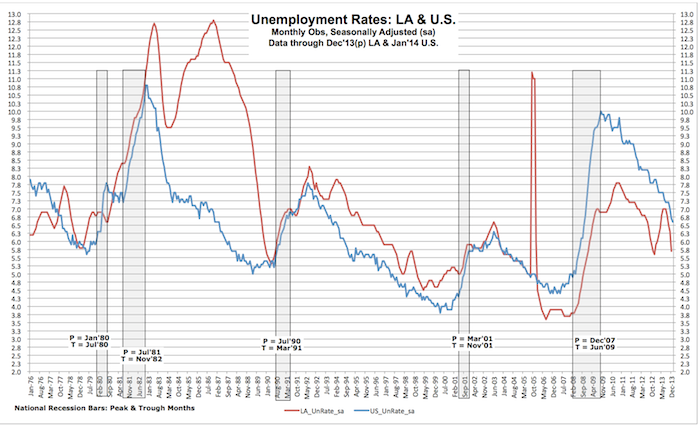
In July, Louisiana’s unemployment rate had been rising steadily and appeared likely to surpass the national rate, which had been dropping.
But since peaking at 7 percent in mid-2013, Louisiana’s rate has been trending back down again and remains lower than the national average.
The latest numbers show that the state had a 5.7 percent jobless rate in December, compared to a national rate of 6.6 percent in January.
And various forecasts indicate Louisiana will continue to create jobs at a good clip, thanks to the booming energy sector.
“We’re heading in the right direction,” said Curt Eysink, executive director of Louisiana Workforce Development, the state agency that oversees the Jindal administration’s employment efforts.
From July through December, the number of employed workers rose by 24,000, according to figures from the federal Bureau of Labor Statistics, a solid showing, according to economists. Job growth was especially strong in manufacturing, while the number of government jobs declined.
[module align=”left” width=”half” type=”pull-quote”]For the first time in state history Louisiana will have more than 2 million jobs by late 2015.[/module]In explaining the state’s decline in joblessness, Jim Richardson, director of the Public Administration Institute at Louisiana State University, cited the continuing heavy investment by private companies in south Louisiana’s oil and gas and petrochemical industries – powered by low natural-gas prices, which cut costs, and high oil prices, which fatten profits.
“Our traditional industries have been rebounding,” Richardson said, declaring 35,000 to 40,000 new jobs per year in Louisiana “a good number.”
Another factor in the unemployment drop is one that the Jindal administration does not advertise: Many workers have stopped looking for work. From July thru December, the number of workers in the civilian labor force dropped by 3,000 in Louisiana, while the unemployment rate was falling by 1.3 percent, Bureau of Labor Statistics figures show.
“People who drop out of the labor force don’t count as unemployed, but they’re not employed,” said Davy Norris, executive director of Enterprise and Economic Development at Louisiana Tech University in Ruston.
But Richardson and Norris give at least some credit to job-creating efforts by Gov. Bobby Jindal and his secretary of economic development, Stephen Moret.
“There’s been a concerted effort by the governor’s staff to appeal to business,” Richardson said.
Richardson and Norris added that Louisiana also is benefiting from the national recovery from the severe recent recession.
The energy sector has spurred the strong job growth in the metro areas of Lake Charles, Lafayette and Houma/Thibodaux, Richardson said. New Orleans has gained more lower-paying service industry jobs, while also attracting some high-tech jobs.
Metro Baton Rouge has gained jobs at a slower pace, Richardson added, although it is poised to rev up. Job growth has been mostly flat over the past six months in the Shreveport, Monroe and Alexandria metro areas.
Richardson and other economists caution that state job numbers can be misleading on a month-to-month basis because the sample size is small; six-month trends provide a more meaningful picture.
The job market will be especially robust in Lake Charles and Baton Rouge this year and next, Richardson and retired LSU economist Loren Scott reported in an annual state economic survey released in October. Metro Baton Rouge “is heading into an industrial expansion like none other in its history,” they found, driven by construction projects, including a technology center for IBM in downtown Baton Rouge that will add 800 jobs.
The economists project that for the first time in state history Louisiana will have more than 2 million jobs by late 2015.
New Orleans will get another 1,000 jobs once the new LSU hospital opens in the second half of 2015, the report projects, with the greater metro region expected to add another 11,000 by the end of 2015, a 1 percent increase. “GNO, Inc. is working a large number of potential projects that could boost our forecast number significantly,” they add, referring to the nonprofit business incubator.
In January, the Greater New Orleans Community Data Center produced a similarly rosy statewide forecast.
“Energy-catalyzed investments in petrochemicals, advanced manufacturing, and the energy industry, totaling $21 billion, will likely be the largest jobs creator in Southeast Louisiana for years to come,” the report said. “The ensuing wave of new job openings will be more than quadrupled by the massive retirement of baby boomers happening at the same time. The majority of 42,000 openings will be in occupations that require just a high school degree complemented by various levels of training — such as welders, machinists, and pump operators — and offer a high median wage between $15 and $35 an hour.”
The Jindal administration — through Eysink’s agency — is putting a major emphasis on trying to ensure that Louisiana’s community colleges, technical colleges and four-year universities produce graduates who can fill the needed jobs; a related effort seeks to get private companies and unions to step up job retraining.
